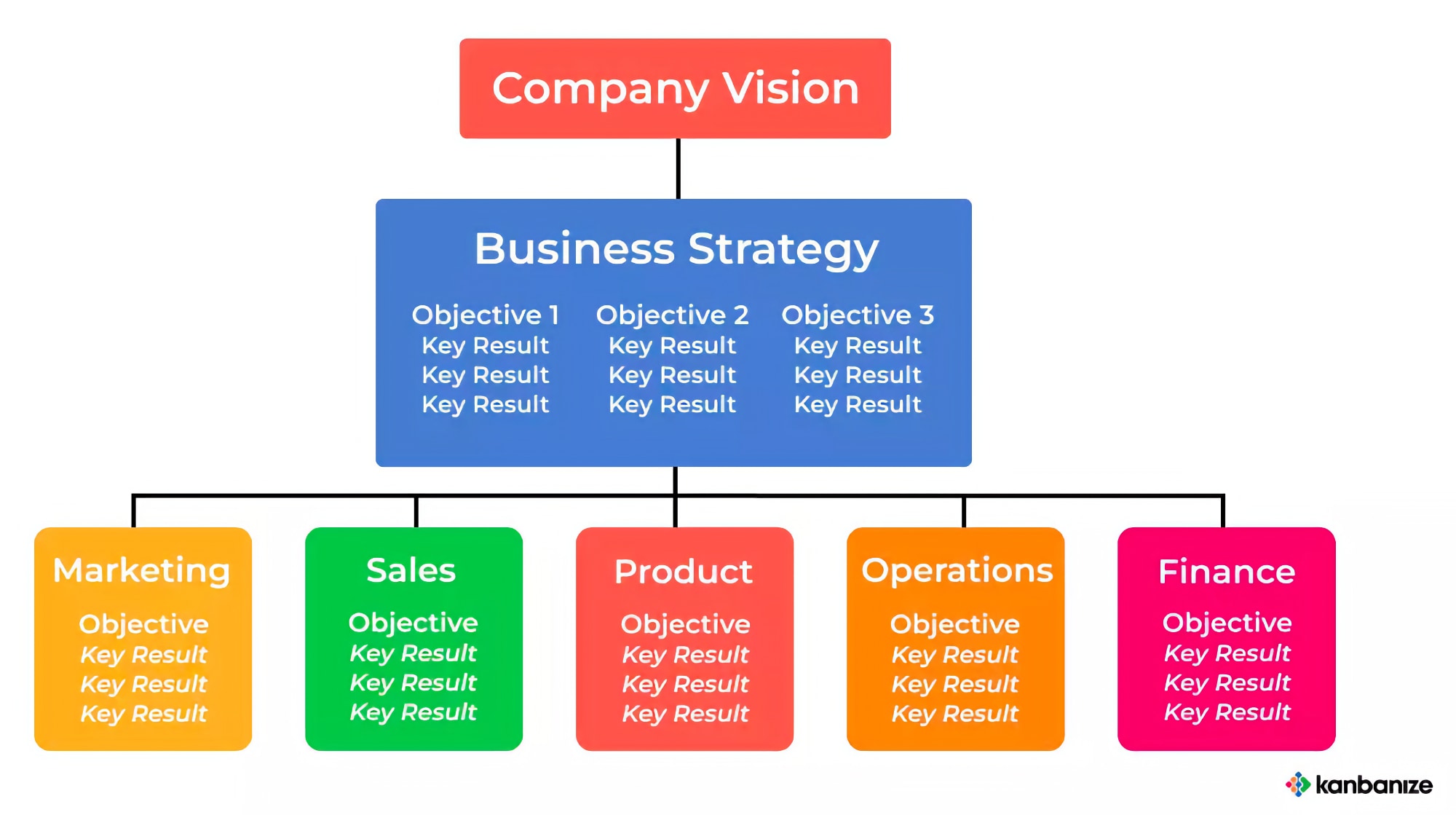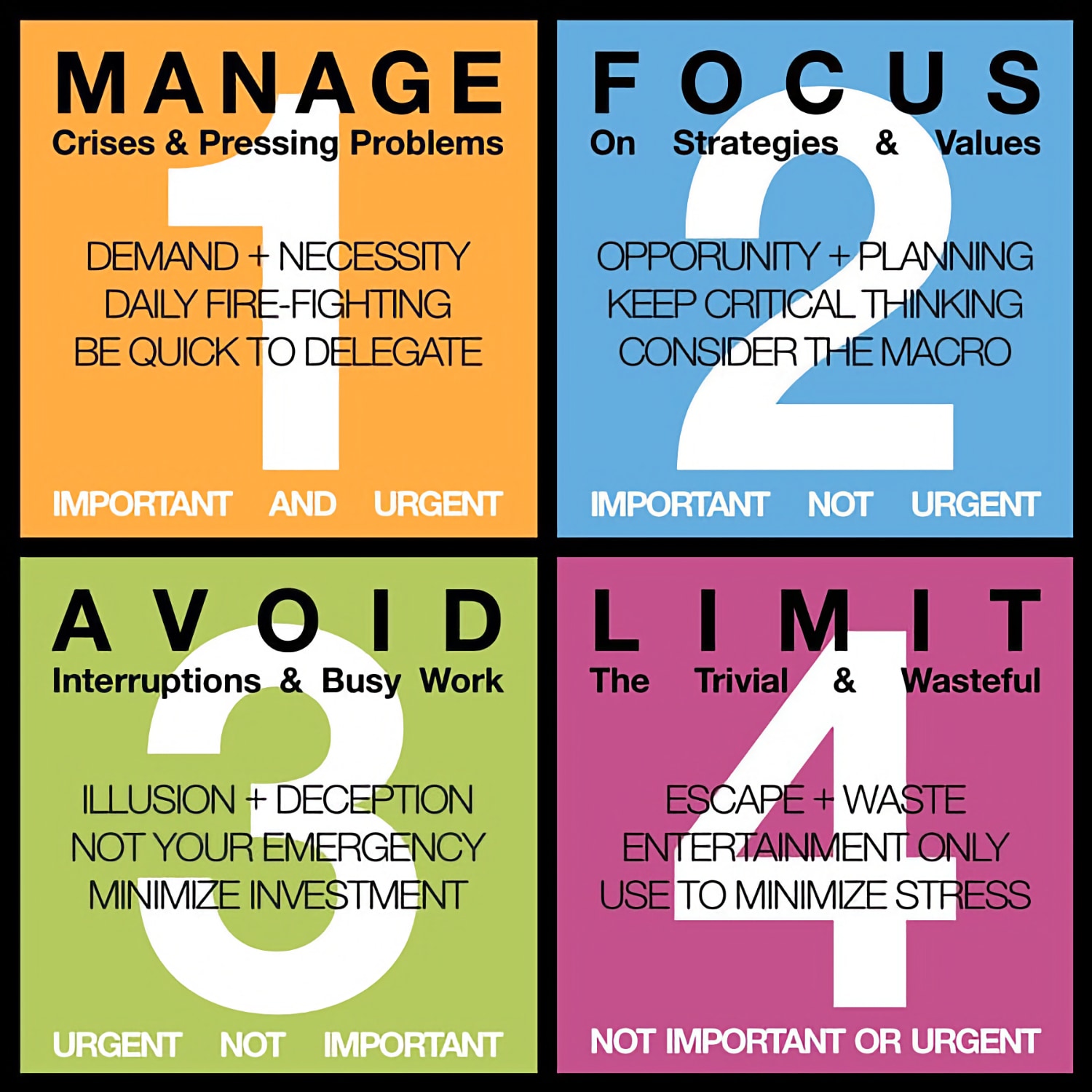
Maximizing Your Digital Product’s Success: The Ultimate Guide to Implementing OKRs
- Product Leadership /
- Product Strategy /
One of the most significant challenges that companies and digital product teams face is maintaining focus. With numerous competing priorities, it is easy to become distracted and lose sight of what is truly important. This lack of clarity can have devastating consequences for the success and growth of a product.
At the heart of this problem is the failure to align objectives and key results with:
- the organization’s strategy and overall mission,
- teams, so they know what is important and what is not, and
- the individual contributor level, ensuring every person knows how their work matters, understands expectations, and knows what success looks like.
When focus and clarity are lacking, frustration, pain, or even catastrophic results may arise. It can lead to missed opportunities, wasted resources, and even the failure of a company. Imagine driving down the road without a destination. Where would you end up? Conversely, picture driving late at night with a clear intended destination, able to see only the 200 feet in front of you as your headlights cut through the darkness. But, you confidently stay the course knowing you will eventually arrive at your intended destination.
This is where OKRs (Objectives and Key Results) can help. OKRs are a popular framework for organizations to set and achieve goals in a transparent and accountable manner. Companies like Google, Twitter, and LinkedIn successfully identify and utilize OKRs.
If you are struggling with focus and prioritizing the important over the urgent, you are not alone. Let us examine the origins of this practice; what OKRs are, their benefits, common mistakes, and best practices to help you build clarity and focus.
The Origins of OKRs
The origins of OKRs can be traced back to Peter Drucker, one of the most well-known and influential thinkers on modern management practices. Drucker believed that business leaders needed to embrace the “spirit of performance”: exhibiting high levels of moral and ethical integrity in their actions, focusing on results, empowering employees, going beyond financial obligations to shareholders, and ultimately serving the common good.
In the 1970s, Andy Grove, Intel CEO, took Drucker’s idea and expanded upon the concept to include Key Results. The idea was brilliant in its simplicity and ability to build alignment at the individual, team, and organizational levels, helping to establish focus at scale.
Today, perhaps the most renowned authority on OKRs is John Doerr. He was originally part of the management team at Intel and later became a leading figure in the Silicon Valley venture capital (VC) space, working at Kleiner Perkins Caufield & Byers and investing in Google in 1999. As an advisor, John introduced OKRs to dozens of the top companies. In 2017, Doerr released his book “Measure What Matters.”
Over the last several decades, there has been a growing movement of dedicated individuals who have continued to guide, implement, and scale the practice of leveraging OKRs. This work has served as a model for building alignment and bringing focus to organizations, helping them realize their vision.
Focus on What’s Important Using OKRs, Not Just What’s Urgent
OKRs have a number of benefits at the individual, team, and organizational levels. For individuals and teams, OKRs can help clarify and focus their goals and track their progress towards those goals. At the organizational level, OKRs can help to ensure that teams and departments are aligned around a common set of objectives. They can also help propel collaboration, promote accountability, and ensure that resources are used effectively. Let’s break down the two parts of OKRs: objectives and key results.
Objectives are the outcomes you want to achieve, not merely outputs. Typically, an organization will focus on 3-5 objectives per quarter. A well-defined objective is qualitative, clearly defining the value (psychological and functional) you want to create for your user or within the business. Objectives should be ambitious, quantifiable, and set in alignment with the business strategy and the company’s vision. Each objective should answer:
- What do we need to improve on to be more successful and move towards
realizing our vision? - Why is this important to our customers and business now?
Key Results are the quantitative milestones that need to be achieved to realize the objectives. Each key result should be specific, measurable, achievable, and set within the context of a timeline. Typically, an organization will focus on 3-5 key results per objective. Once defined, a team can identify the necessary initiatives and tasks to realize the key result, driving progress to attain the larger objective. Each key result should answer:
- Where will we need to focus our efforts?
- How will we know we’re improving?
- Can we measure it on a regular basis?

Deciding Where to Focus and Defining Effective OKRs
Defining good OKRs is challenging, even for those experienced in the process and facilitating it with others. Good OKRs begin with a clear and compelling strategy. Implementing OKRs successfully requires a shared understanding of the vision and product strategy across the entire company. Your strategy serves as the foundation on which everything else is built. It informs everyone of what is important and what is not, it builds alignment, and connects the “why” behind your OKRs.
Jeff Gothelf illuminates the significance of strategy in his article Scaling OKRS, Part 1: Strategy is the Foundation: “Additionally, conflicts become easier to resolve because the strategy provides an objective lens through which to examine the relevance and validity of pet projects, personal preferences and arbitrary choices, for example. All those things quickly disappear when placed under the lens of a clear strategy. As teams present their OKRs and goals, they have to tell their own compelling story about how the goals they chose and the accompanying solution hypotheses will help achieve the strategy.”
OKRs can be a powerful tool. But, like any tool, OKRs can also present some challenges for both new and mature adopters, spotlighting areas of the business that may need extra attention. Some of the biggest challenges and common mistakes are:
- Leadership staying aligned. Not being reactive to what feels urgent but is not the most important issue.
- Not aligning OKRs from the bottom up with contributors and cross-functionally.
- Setting too many OKRs, leading to confusion and overwhelming team members.
- Setting ambitious OKRs that are unrealistic.
- Establishing objectives that are vague and can be interpreted differently by various people across the organization.
- Key results are focused on outputs rather than outcomes.
- Key results are based on measurements that do not allow tracking of progress over time.
- Key results are dependent on one another, not allowing for independent workstreams.
- Confusing key results with initiatives and tasks.
- Planning initiatives that would take multiple quarters to complete without breaking them down into manageable chunks.
- Inconsistent or unnecessarily complex scoring frameworks.
- Irregular OKR reviews, status updates, and missed opportunities to course correct.
OKR Example 1
- Poorly Defined OKR:
Objective: Improve customer satisfaction
Key Result 1: Get more positive reviews
Key Result 2: Reduce customer complaints
In this example, the Key Results lack clear targets or ways to measure progress. It’s unclear how many positive reviews are needed or what quantifiable change is needed to reduce customer complaints.
- Effectively Defined OKR:
Objective: Improve customer satisfaction
Key Result 1: Increase the average customer satisfaction rating from 3.5 to 4.5 stars by the end of Q2
Key Result 2: Reduce the average response time to customer inquiries from 24 hours to 2 hours within 3 months
In this example, the Key Results are specific, measurable, and time-bound, providing clear targets for the team to work towards.
OKR Example 2
- Poorly Defined OKR:
Objective: Increase company growth
Key Result 1: Hire more people
Key Result 2: Open new offices
This OKR set doesn’t focus on the outcomes or impact of the actions. Hiring more people and opening new offices may not necessarily lead to company growth. Instead, Key Results should focus on specific, measurable outcomes tied to growth, like revenue targets or market share.
- Effectively Defined OKR:
Objective: Increase company growth
Key Result 1: Achieve a 20% increase in quarterly revenue by the end of Q4
Key Result 2: Expand market share by 5% within the next 6 months
These Key Results focus on quantifiable outcomes tied to growth, such as revenue and market share, providing a clear direction for the team’s efforts.
OKR Example 3
- Poorly Defined OKR:
Objective: Enhance team collaboration
Key Result 1: Conduct weekly meetings
Key Result 2: Implement a new communication tool
These Key Results are focused on activities rather than measurable outcomes. While weekly meetings and new communication tools may improve collaboration, it’s not clear how to gauge their success. Key Results should be centered on specific, quantifiable improvements, such as reducing project completion times or increasing the percentage of cross-functional projects. - Effectively Defined OKR:
Objective: Enhance team collaboration
Key Result 1: Decrease project completion times by 15% within the next quarter
Key Result 2: Increase the percentage of cross-functional projects by 10% by the end of the year
In this case, the Key Results are centered on specific, quantifiable improvements in team collaboration, which can be tracked and evaluated over time to assess the team’s progress.
OKRs are not a one-size-fits-all solution. Different teams and organizations have varying needs. It’s crucial to tailor the OKR process to accommodate the specific requirements of each unique scenario. OKRs make outcomes agile and can necessitate a shift in mindset, potentially leading to an evolution of the company culture.
The OKR Process
Once you’ve defined your OKRs, it’s crucial to follow a process to ensure their effectiveness. The OKR process generally consists of four steps:
- Setting objectives that inspire and move the business forward.
- Designing key results and associated initiatives.
- Tracking progress on a regular cadence.
- Evaluating results, lessons learned, and maintaining alignment.
The first step in the OKR process is setting objectives. This involves defining the long-term goals that you want to achieve and setting them within the context of a timeline. The second step is designing key results, which involves defining the measurable milestones needed to reach the objectives. The third step is tracking progress, which involves monitoring progress towards the objectives and key results, and making adjustments as needed. The fourth step is evaluating results, assessing the success of the OKRs and taking action as needed.
While there are a plethora of great resources available detailing the process of defining and implementing OKRs (check out Reforge’s 6-Step process), I want to focus on separating the important objectives from the urgent objectives that tend to consume our time and resources. Fundamentally, this entails ensuring that you’re focusing on the right things, at the right time, in the right order.
1: Identifying What’s Most Important to Inform Your OKRs
Stephen Covey is one of the most respected authorities on leadership. His work “The 7 Habits of Highly Effective People,” was named the most influential business book of the twentieth century. Covey emphasized the importance of separating the most important tasks from the urgent tasks. This approach has been a powerful and effective method for leaders across business and product teams to delineate priorities and build alignment.
“Anything less than a conscious commitment to the important is an unconscious commitment to the unimportant.” – Dr. Stephen R. Covey
The initial framework was introduced in the context of time management. If time is our greatest asset and the one thing we can’t buy more of, then it’s exactly the lens we need to help bring focus to our OKRs.
Each quadrant has a different weight and is designed to help you prioritize your activities and responsibilities. These quadrants are as follows:
- Quadrant 1: Urgent and important
- Quadrant 2: Important but not urgent
- Quadrant 3: Urgent but not important
- Quadrant 4: Not important and not urgent

First, make a list of all the objectives you need to complete in order to realize your product strategy and company vision. Ensure that each objective is written in a clear and concise statement. This will help you prioritize your work and track your progress.
Next, list all the objectives and their respective deadlines to effectively prioritize your work. This will help you identify which objectives require immediate attention and which objectives can be accomplished later. Take note of the approaching deadlines to determine the urgency of the objectives in the next step.
To prioritize your objectives better, identify the deadlines that are quickly approaching. This will help you understand which objectives are more pressing than others. It will also give you a comprehensive view of all the organization and/or team’s responsibilities. It will also help you decide which objectives require immediate attention and which objectives can wait.
To effectively manage your objectives, prioritize them based on their level of importance. This way, you can easily identify which objectives require immediate attention and which objectives can be postponed. You’ll then be able to create a schedule that allows you to accomplish urgent objectives in order of importance.
Once you have evaluated each objective, group them into their respective quadrant – urgent, important, both, or neither. Use this matrix to organize and manage your objectives efficiently and complete them within your preferred timeframe, available resources, and business needs.
2: Understanding the Interdependencies between Your Prioritized OKRs
You may often face multiple competing objectives that are urgent and important.It can be a daunting task to determine which objectives require immediate attention. Attempting to tackle all opportunities and problems at once is impossible, but creating a prioritization list and committing to your OKRs is more manageable and progressive. How can you reconcile this problem? One of the most effective tools for this is to map their interdependencies between one another. This will give you a line of sight into where you need to start.
If you need a framework to help facilitate this process, I would recommend the Hoshin Star Prioritization approach, which is a proven method to help organizations visualize the interdependencies and build alignment.
3: Leverage OKRs to Build a Common Language and Understanding
As human beings, we crave acknowledgement, appreciation, and the opportunity to contribute positively. When we consider OKRs for our business and to guide our digital products efforts, the absence of a universal language can be crippling. OKRs offer another opportunity to build a common language and understanding across the entire business, streamlining communication and collaboration. It doesn’t matter if you’re in product, marketing, sales, finance, operations, or any other department – the challenge remains the same.
As you embrace the OKR process, realize you’re building a shared understanding based on the language you use, elevating the competency of everyone.
Conclusion
Objectives and Key Results (OKRs) is a powerful goal-setting framework that can be used to set and track measurable goals. In this guide, we’ve discussed what OKRs are, their benefits, common pitfalls to avoid, and how to define effective OKRs to help you get started. If you are struggling with focus or have been trying to leverage OKRs, it’s now time to unlock your OKR potential and bring focus to what matters most and start tracking toward your goals!
Bonus!
One of those remarkable individuals supporting organizations and product teams understanding OKRs is Christina Wodtke, author of Radical Focus. Check out her interview on Lenny’s Podcast:
Also check out Pawel Huryn’s article “Beware of OKRs. 90% of companies use them wrong.”
Colleen Murphy, Copy Editor